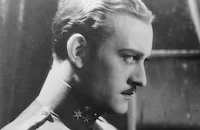The Michigan Kid
Cast & Crew
Irvin Willat
Renée Adorée
Fred Esmelton
Virginia Grey
Conrad Nagel
Maurice Murphy
Film Details
Technical Specs

Synopsis
Jimmy Cowan leaves home as a young boy to seek his fortune in Alaska so that he may marry his childhood sweetheart, Rose Morris. He becomes known as the Michigan Kid, a notoriously lucky gambler and proprietor of a gambling hall. Hayward, Cowan's boyhood rival for Rose, also resides in Alaska. He has sent for Rose, intending to marry her, but when he loses at gambling some money belonging to his company and shoots the dealer, he is forced to escape to a hiding place, leaving Cowan to meet Rose's train. Cowan and Rose renew their acquaintance, and when Rose decides that Hayward is unworthy of her love, she marries Cowan.

Director
Irvin Willat
Cast

Renée Adorée
Fred Esmelton

Virginia Grey

Conrad Nagel
Maurice Murphy
Adolph Milar
Lloyd Whitlock
Donald House
Crew

Film Details
Technical Specs

Articles
Virginia Grey (1917-2004)
She was was born in Los Angeles on March 22, 1917, and was exposed to the film industry at a very young age. Her father, Ray Grey, was a Keystone Cop and acted in several other of Mack Sennett's comedies with the likes of Mabel Normand, Dorothy Gish and Ben Turpin. When her father died when she was still a child, Virginia's mother encouraged her to join the acting game and audition for the role of Eva for Uncle Tom's Cabin, a big budget picture for Universal Studios in the day. She won the role, and acted in a few more pictures at the studio: The Michigan Kid and Heart to Heart (both 1928), before she decided to temporarily leave acting to finish her schooling.
She returned to films after graduating from high school, and after bouncing around Hollywood doing bits for various studios, she hooked up with MGM in 1938. Her roles in her first few films were fairly non-descript: In Test Pilot and Ladies in Distress (both 1938), she did little more than look pretty, but in the following year she had scene-stealing parts in The Women (upstaging Joan Crawford in a delicious scene as a wisecracking perfume counter girl) and as the suffering heroine in Another Thin Man (both 1939).
Despite her versatility (she could handle comedy or drama with equal effectiveness), MGM would cast her in some above-average, but hardly starmaking movies: Whistling in the Dark, The Big Store (both 1941), and Tarzan's New York Adventure (1942). She left MGM in 1943 and became a freelance actress for several studios, but her material as a leading lady throughout the '40s were mediocre: Swamp Fire, House of Horrors (both 1946), and Mexican Hayride (1948) were sadly the more interesting films in her post-MGM period. But by the '50s she was a well-established character actress, appearing in fairly big-budget pictures: All That Heaven Allows, The Rose Tattoo (both 1955), Jeanne Eagels (1957).
In the '60s, Grey turned to television and found work on a variety of hit shows: Wagon Train, Peter Gunn, Bonanza, My Three Sons, I Spy, and several others; plus she also captured a a couple of notable supporting parts in these films: Madame X (1966), and Airport (1970), before retiring completely from acting in the early '70s. She is survived by her sister, Lorraine Grey Heindorf, two nieces and two nephews.
by Michael T. Toole

Virginia Grey (1917-2004)
Quotes
Trivia
Notes
The following persons worked on the treatment and adaptation but were not given screen credit: J. G. Hawks, Charles Logue, and Irvin Willat.














